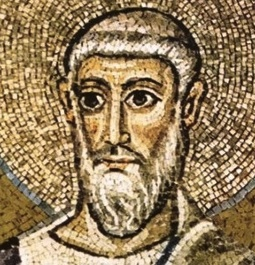
Written by guest blogger Kenneth J. Howell.
In this most recent issue of the Toronto Journal of Theology I have published an article on the 5th century bishop of Ravenna, Peter Chrysologus, who preached four sermons on the story of the woman with a twelve-year hemorrhage in Mark 5: 21-43. This pericope has always fascinated me from literary, theological, and spiritual standpoints.
As a literary piece I find the story interesting because it praises an unknown woman whom Jesus healed. Why did Mark include this story in his gospel? Peter Chrysologus does not answer this question but he does see in this poor woman an exemplar of faith, so much so that he cannot resist appealing to his congregation centuries after the event to imitate her deep faith. Given that women were generally not celebrated for their strength in antiquity–though think of Antigone by Sophocles as a stalwart exception–Peter lauds this woman and her strength as worthy of his highest praise. The suffering woman who wanted to remain anonymous in the original story ends up being proclaimed to the world for her strength of character.
From a theological standpoint, Peter sees three continuities between the original story and the congregation of his own time. Like the hemorrhaging woman, Peter sees every Christian as desperate for healing as he also sees the presence of the most important participant who is Jesus himself. That continuity of Jesus’s presence means that the liturgy of the Church reenacts and embodies the same reality present to the woman of the 1st century. The concrete link between past and present is the Eucharist. As Peter insists, the same healing power that the woman found is also in the Eucharist. The only remaining continuity is that of faith. Will Peter’s fellow Christians believe in the Eucharist as an embodiment of Christ himself? Will they reach out and touch “the hem of Jesus’s garment?” The profound spirituality of that woman begs that response from Peter’s congregation–and I might add from us.
Kenneth J. Howell is the Director of Academic Research of the Eucharist Project and President of the Pontifical Studies Foundation which supports the work of the project. Dr. Howell taught in higher education for almost thirty years, most recently for over a decade as a Professor of Religion at the University of Illinois (Urbana-Champaign) where he taught classes on the history, theology, and philosophy of Catholicism. At the same time, he served as the Director of the Institute of Catholic Thought of the St. John’s Catholic Newman Center at the same university.
His latest article in the Toronto Journal of Theology entitled “The Eucharist as a Hermeneutical Lens in the Preaching of Peter Chrysologus” is free to read for a limited time here.
The UTP Journals blog features guest posts from our authors. The opinions expressed in these posts may not necessarily represent those of UTP Journals and their clients.
Comments on this entry are closed.